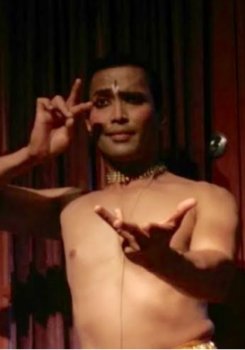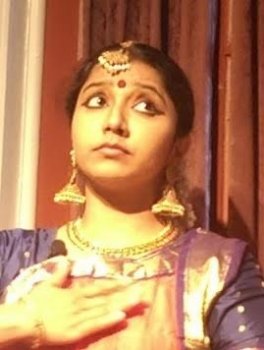
|   |

|   |
'Soaked in Love' in San Francisco - Poornima Ramaprasad e-mail: poornima@sbcglobal.net July 22, 2016 Driving to the city for a Bharatanatyam program is a crazy thought given that there are innumerable opportunities to watch these in the south bay. But when you have a week off from work and the teenager at home thinks it is fun, I made up my mind to drive for 90 minutes, find parking for 20 minutes and walk to the venue for 20 minutes, all to be told that the small venue was full and to be in line with fire code, they could not take any more folks in. With my ‘good person’ looks, I begged my way in, to be seated on the floor right in front of the dancers and bingo! That was the best seat in the house. I turned around to look if I could find some known faces, yes, there were a few lovely dancers from my neck of the woods, a few more of my kind and a host of so-called 'foreigners', young, old, couples, people in love, etc. For a second I questioned myself, "Wait, the event is called Shades of Love… Did these folks think it was something to do with Fifty Shades"? But to my pleasant surprise, it was one of the best crowds I have ever seen, enjoying Bharatanatyam, abhinaya, meaning of the lyrics, the culture, asking interesting questions and checking for clarifications. By midway of the performance, I saw most of them emoting and miming for the sahitya along with the dancers! I couldn't stop seeing couples living the moments of the dance too. And all this was in a very intimate setting, a typical chamber concert at Red Poppy Arthouse in the Mission district of San Francisco. ‘Shades of Love - Padams and Javalis’ was a beautiful lecture/demonstration/performance program, exclusively featuring padams and javalis. It was presented by two of the leading upcoming dancers in Bay Area Bharatanatyam arena - Ganesh Vasudeva and Snigdha Venkataramani on July 8, 2016. Ganesh is a disciple of many renowned gurus including Chandrashekar Navada and Bragha Bessel and Snigdha is a disciple of Saroja Vaidyanathan. The presentation was to showcase ‘Love / Sringara’ with all its subtle expressions in the male and the female domain. The show had to cater to a wide spectrum of audience including first time watchers, so the presentation went in a very slow pace giving a clear idea of the art form, the genre, the story, the abhinaya, the hastas, the mudras, the physical aspects (angika abhinaya), the meaning of the lyrics and finally going to the performance for actual singing.  Ganesh Vasudeva began the concert with the wonderful javali by Pattabhiramayya “Taaru maaru tadevemi bajaari” in ragam Natakurunji. This is a very popular javali for a male dancer, where the nayaka is expecting so much from his lady love. He thinks she has to give in to his feelings at his will. When the nayika shows disinterest in him, he tries to flirt with her while still maintaining his male ego and is finally angry and sad that she does not give in. Ganesh succeeded in his depiction of a drishta nayaka here, with a myriad of expressions from showing his male ego, his superiority, his pacifying skills while still accusing his lover, his anger, guilt and finally rejection. This clearly was his best item in the show. The next item by Ganesh was “Emi seyyudu,” a Kshetrayya padam in Kambhoji, set to khanda chapu tala. In this, he is a virahi, he is Lord Muvvagopala who is feeling the pangs of separation from his beloved. He describes, very delicately, how he could draw her picture, but cannot fill it with her fragrance, how he could draw her lips, but cannot fill it with nectar, how he could draw her eyes, but cannot draw her shy glances and so on. He wants her by him and is pleading as to how that could happen. Ganesh’s next presentation was “Daani bodhana vina vadduraa” in raga Suruti. Suruti is an auspicious raga, and if handled well, can be used for a variety of emotions. Although the lyrics of the song were not particularly that of happiness, it did not stick out per se. In this song, the heroine accuses the hero, here Lord Brihadeeshwara, of being with the other woman and being enchanted by her, when she is waiting for him and expecting his tenderness. She is sad that he is not giving her the love and closeness she expects from him and finally gives up feigning anger. There were several shades of the heroine’s love and similarly, shades of hero’s love too. Ganesh handled both the heroine’s and the hero’s role quite aptly, much to the audience’s appreciation and momentary laughs. “Janaro ee mohamu” in Khamas, again by Ganesh depicted yet another shade of sringara rasa, the infatuation felt by the nayika as she tells her sakhi how she is eager for her union with the lotus eyed Lord Srinivasa. This was followed by “Nee laalana chaalu nilparaa”, another Pattabhiramayya composition in raga Dhanyasi, which was a very pleasing song, but, felt a little repetitive after the above list. Snigdha Venkataramani is a very versatile artist. She is a sought after vocalist for Bharatanatyam productions by leading dancers and arangetrams and is a dancer herself. This time, she took it to the next level by singing for her own dance. Snigdha presented 2 solo items. The first one was the famous javali in Behag, a composition of Swati Tirunal “Saaramaina maatalento chaalu chaalu raa.” In this she plays a virahotkhantita naayika, which in my view is one of the easy ones for an expressive dancer. Snigdha displayed wonderful abhinaya in this piece and got warm approval and admiration from the audience. 
Snigdha Venkataramani
In another solo, Snigdha was taking a very sensitive subject of child marriage in India in the padam “Mukku pacchalarani” in raga Yadukula Kambhoji, a composition of Dasu Sreeramulu. She depicted a playful girl, a child who wants to be with her parents playing and resting. She knows she is married to an unattractive, rather old man and is begging her Lord Venugopala and her parents not to let her go. Finally she resolves that the time had come for her to leave her parental home to her husband’s home and gives in to her fate. Snigdha chose a very touching elaboration to bring out a social issue to the table. The program concluded with a duet by Ganesh and Snigdha where they chose two padams, both in Saveri, “Muttavaddu raa” by Snigdha and “Mutta raadate” by Ganesh – both going in parallel from the hero’s and the heroine’s perspective. Each of them did a very good job in their presentation ending the concert with a bang. Definitely, through this experimental presentation, these artists have taken Bharatanayam to the next level, to the non-traditional audience. I appreciate their efforts in taking this bold step, without having to compromise on what Bharatanatyam stands for. Contrary to the belief of most experimental performers that costumes, upbeat choreography, leaning to current affairs or taking a western theme and adapting to Bharatanatyam and doing a more than perfect presentation would lure western and non-traditional audience, this duo did not budge from the traditionalism of the art. They successfully presented it, even though it was in a small scale. Snigdha Venkataramani and Srinivas Pisharath did well on vocals and were ably supported by Nayantara Narasimhan on the violin and Akshay Venkatesan on the mridangam, both these accompanists being upcoming young musicians. It would have been interesting to see another dimension of love like in a Meera bhajan or an Akka Mahadevi vachana to avoid some repetitive shades through the presentation. In the last item the duet “Muttavaddu raa / Mutta raadate,” although each was doing a good job, it did not come together either as a duet or as a jugalbandhi. Possibly, it would have done well with a little more chemistry between the artists. The scope of the presentation was such that there was not much need for loaded footwork, so I would not qualify that as a slip. Wishing this duo much success in popularizing this traditional art form of India, as it should be, to off beat audience in the San Francisco Bay area and farther. Poornima Ramaprasad follows Indian classical music and dance forms. She reviews Indian dance and drama events in the San Francisco Bay area from time to time. |